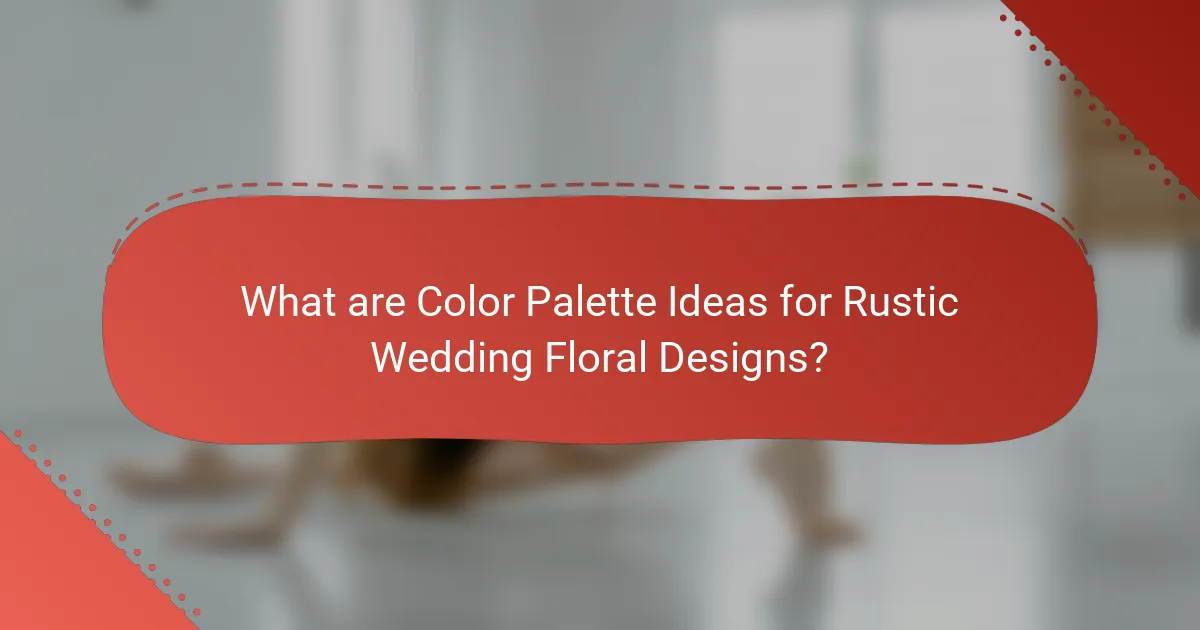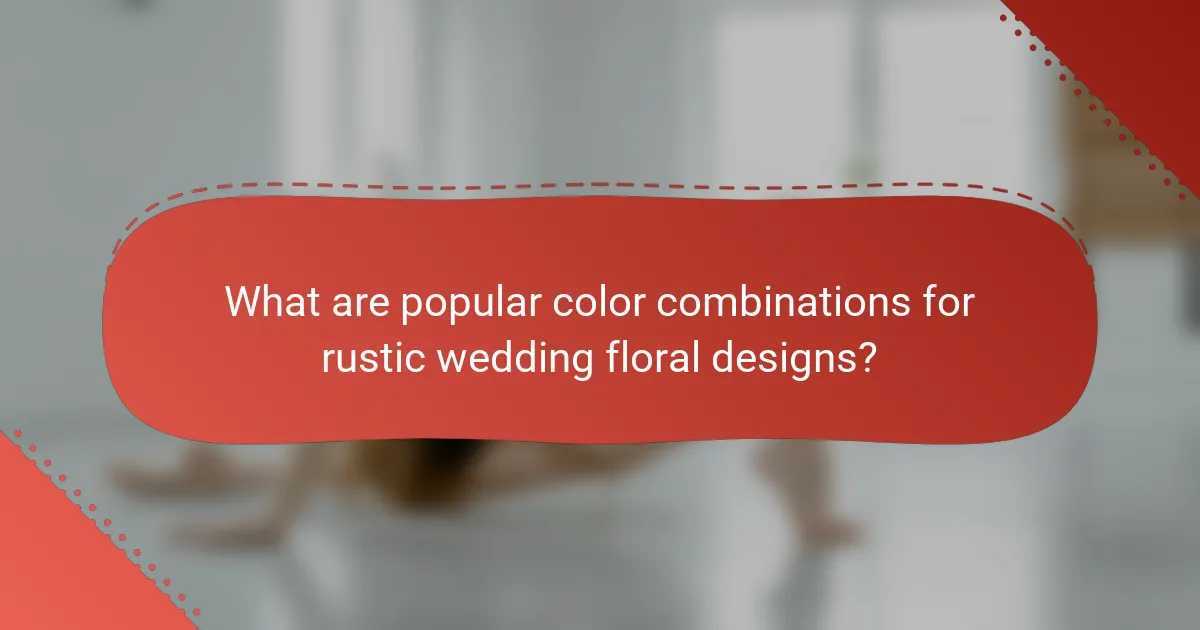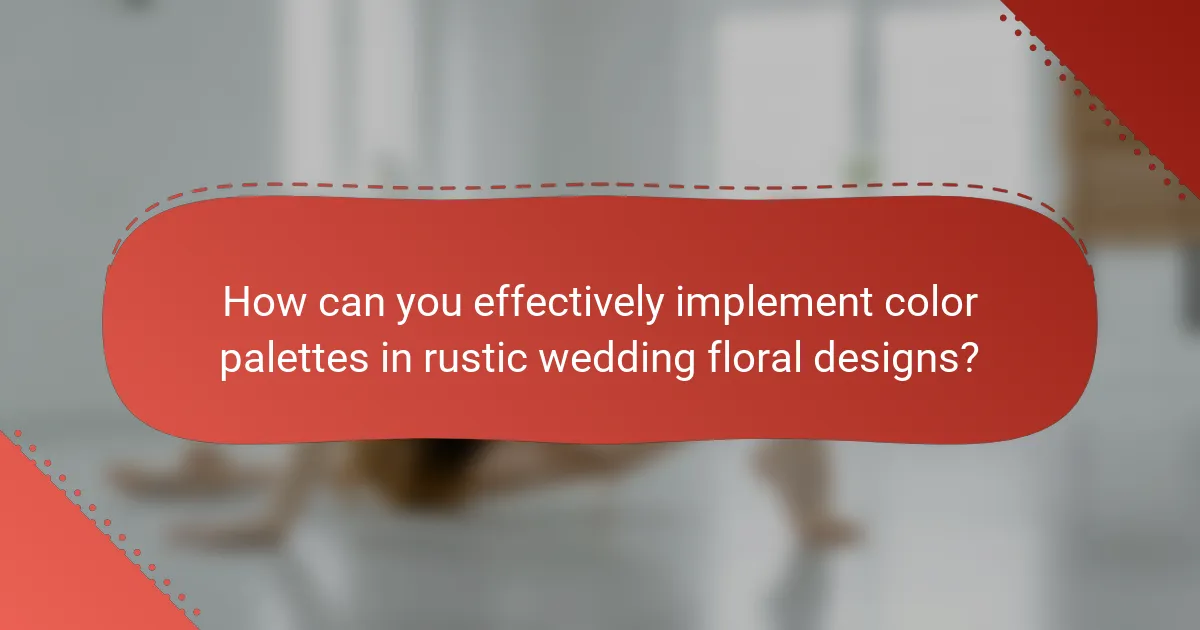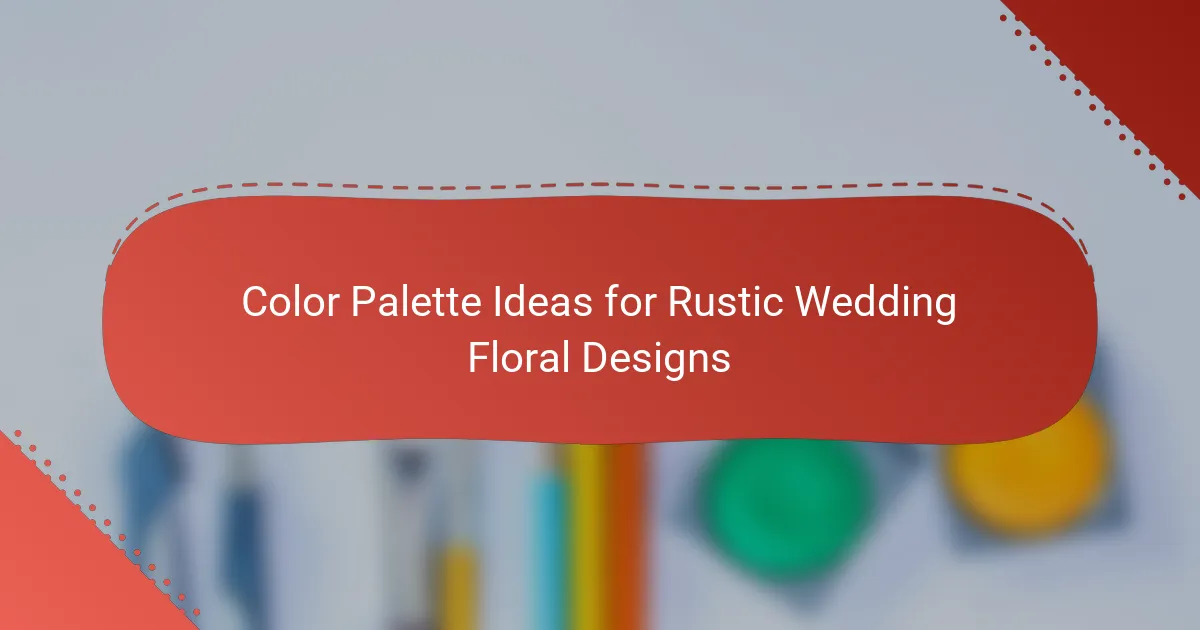
What are Color Palette Ideas for Rustic Wedding Floral Designs?
Color palette ideas for rustic wedding floral designs often include earthy tones and natural hues. Popular choices are deep greens, soft browns, and muted oranges. These colors reflect the beauty of nature and complement rustic settings. Combining shades like burgundy and dusty rose adds elegance. Incorporating cream and ivory provides a soft contrast. Accent colors such as navy blue or mustard yellow can enhance the palette. These combinations create a warm and inviting atmosphere. Many couples choose these palettes to evoke a cozy, organic feel for their wedding.
How do color palettes influence rustic wedding floral designs?
Color palettes significantly influence rustic wedding floral designs by determining the overall aesthetic and mood. A cohesive color palette enhances the natural beauty of rustic settings. Earthy tones like greens, browns, and creams reflect the organic elements of rustic themes. Bright, vibrant colors can add a lively contrast to neutral backdrops. The choice of colors affects flower selection and arrangement styles. For example, muted colors often lead to softer, more romantic designs. In contrast, bold colors can create striking focal points. This alignment with color palettes ensures floral designs resonate with the wedding’s overall theme.
What are the key elements of a rustic wedding floral design?
Key elements of a rustic wedding floral design include natural textures, seasonal blooms, and earthy color palettes. Natural textures often come from foliage, branches, and twine. Seasonal blooms ensure that flowers are fresh and relevant to the time of year. Earthy color palettes typically feature muted tones like greens, browns, and soft pastels. Additionally, wildflowers are commonly used to enhance the organic feel. Varied heights in arrangements create visual interest. Finally, incorporating elements like mason jars or wooden containers emphasizes the rustic theme. These components work together to create a cohesive and charming rustic floral design.
How do different colors evoke emotions in wedding themes?
Different colors evoke specific emotions in wedding themes. For instance, red symbolizes love and passion. It can create an intense and romantic atmosphere. Blue represents calmness and serenity. It is often associated with trust and loyalty. Yellow conveys happiness and warmth, promoting a cheerful ambiance. Green is linked to nature and growth, fostering a sense of harmony. Purple signifies luxury and elegance, adding a regal touch to the theme. Each color’s psychological impact influences guests’ feelings and overall experience during the wedding. Research shows that color psychology plays a significant role in emotional responses.
Why is choosing the right color palette important for rustic weddings?
Choosing the right color palette is crucial for rustic weddings because it sets the overall mood and theme. A well-chosen palette enhances the natural beauty of rustic settings. It harmonizes with elements like wood, greenery, and vintage decor. Specific colors can evoke emotions and create a cohesive look. For example, earthy tones resonate well with rustic aesthetics. They complement natural surroundings and enhance floral arrangements. Research shows that color influences perceptions and feelings, impacting guest experiences. Thus, the right palette elevates the wedding’s visual appeal and emotional atmosphere.
What impact does color have on the overall wedding atmosphere?
Color significantly impacts the overall wedding atmosphere. It influences emotions and sets the tone for the event. Different colors evoke different feelings; for example, soft pastels create a romantic ambiance. In contrast, bold colors can energize the space and create excitement. The choice of color can also reflect the couple’s personality and style. According to a study published in the Journal of Personality and Social Psychology, colors can affect mood and behavior. Thus, selecting the right color palette is crucial for achieving the desired atmosphere at a wedding.
How can color palettes enhance floral arrangements?
Color palettes enhance floral arrangements by creating visual harmony and emotional impact. A well-chosen color palette can unify diverse flower types. It can also evoke specific moods, such as romance or tranquility. For example, warm colors like reds and yellows can create a vibrant atmosphere. In contrast, cool colors like blues and greens tend to promote calmness. Color theory supports these effects by demonstrating how colors interact. Analogous colors create a cohesive look, while complementary colors add contrast and interest. Research shows that color influences perception and emotional responses in design. Thus, selecting an appropriate color palette is essential for effective floral arrangements.

What are popular color combinations for rustic wedding floral designs?
Popular color combinations for rustic wedding floral designs include burgundy and blush, navy blue and gold, and sage green with ivory. Burgundy and blush create a romantic atmosphere, while navy blue and gold add elegance. Sage green and ivory provide a fresh, earthy feel. These combinations are favored for their ability to complement natural settings. They enhance the rustic charm of outdoor venues. Many couples choose these palettes for their versatility and timeless appeal.
How can earthy tones be incorporated into floral designs?
Earthy tones can be incorporated into floral designs by selecting flowers in shades of brown, green, and muted colors. These tones create a natural and organic feel. For instance, using flowers like dahlias, sunflowers, or eucalyptus can enhance the earthy aesthetic. Incorporating foliage and branches in similar hues adds depth to the arrangement. Using natural materials, such as burlap or wood, as part of the design can complement the earthy theme. Additionally, choosing vases in terracotta or stone finishes can further enhance the rustic look. This approach aligns with current trends in floral design, emphasizing sustainability and nature-inspired aesthetics.
What are examples of earthy color palettes for rustic weddings?
Examples of earthy color palettes for rustic weddings include warm browns, muted greens, and soft neutrals. These colors reflect natural elements found in rustic settings. For instance, a palette might consist of sage green, taupe, and cream. Another example is deep burgundy combined with burnt orange and golden yellow. A third option could feature olive green, rust, and beige. These combinations evoke a cozy and organic atmosphere. Earthy palettes often incorporate colors inspired by nature, such as terracotta and dusty rose. Such choices enhance the rustic charm of wedding decor.
How do earthy colors complement traditional rustic elements?
Earthy colors enhance traditional rustic elements by creating a harmonious and natural aesthetic. These colors, such as browns, greens, and muted tones, reflect the organic materials often used in rustic design. They evoke a sense of warmth and comfort, making spaces feel inviting. Earthy colors also help to ground the overall decor, connecting it to nature. This connection is essential in rustic settings, where wood, stone, and other natural materials are prevalent. The use of earthy tones can highlight these materials, allowing them to stand out. Additionally, they provide a versatile backdrop for floral arrangements, enhancing the overall visual appeal. This synergy between color and materials reinforces the rustic theme effectively.
What vibrant colors work well in rustic wedding floral arrangements?
Vibrant colors that work well in rustic wedding floral arrangements include deep reds, bright oranges, and rich yellows. These colors complement the earthy tones typically found in rustic settings. Additionally, shades like burgundy and plum add depth and sophistication. Bright pinks and corals can introduce a lively contrast. Sunflowers and daisies in yellow and white can enhance the cheerful atmosphere. Incorporating greenery, such as eucalyptus, can balance these vibrant hues. These color combinations create a harmonious and inviting floral display.
What are some examples of vibrant color palettes for rustic themes?
Vibrant color palettes for rustic themes often include rich, earthy tones combined with bold colors. One example is a palette of deep burgundy, mustard yellow, and forest green. This combination evokes warmth and natural beauty. Another example features vibrant coral, teal, and cream. These colors create a fresh and lively atmosphere. A third option is a mix of burnt orange, navy blue, and cream. This palette provides a striking contrast while maintaining a rustic feel. Such color combinations enhance the organic elements often found in rustic designs. They are commonly used in floral arrangements, table settings, and decor.
How can vibrant colors contrast with rustic decor?
Vibrant colors can create a striking contrast with rustic decor by adding visual interest and energy. Rustic decor typically features natural materials and muted tones, such as wood and earth colors. When vibrant colors, like bright reds or deep blues, are introduced, they stand out against these subdued backgrounds. This contrast draws attention and highlights specific decor elements. For example, a vivid floral arrangement can pop against a wooden table setting. This use of color can evoke emotions and create a lively atmosphere. Studies show that color contrasts can enhance visual appeal in design. Therefore, incorporating vibrant colors effectively enhances rustic decor.

How can you effectively implement color palettes in rustic wedding floral designs?
To effectively implement color palettes in rustic wedding floral designs, choose colors that complement natural elements. Earthy tones like greens, browns, and muted pastels work well. Incorporate seasonal blooms that reflect the chosen palette. For example, combine sunflowers with soft lavender and cream for a warm feel. Use foliage to add depth and enhance color harmony. Textures also play a crucial role; mix smooth petals with rougher elements like twigs or burlap. This approach creates visual interest and aligns with rustic aesthetics. Research indicates that color psychology influences mood, making thoughtful palette choices essential for the wedding atmosphere.
What tips should you consider when selecting a color palette?
Consider the theme and mood of the wedding when selecting a color palette. A rustic wedding often features earthy tones and natural colors. Choose colors that complement the venue and surroundings. Look for inspiration in nature, such as flowers and foliage. Limit the palette to three to five colors for cohesion. Test color combinations to ensure they work well together. Use online tools to visualize color pairings. Consider seasonality; certain colors resonate more during specific seasons.
How can seasonal flowers influence your color choices?
Seasonal flowers can significantly influence your color choices by providing a natural palette that reflects the time of year. Each season offers distinct flowers with unique colors. For example, spring flowers like tulips and daffodils bring vibrant yellows and soft pastels. Summer blooms such as sunflowers and dahlias introduce bold oranges and deep reds. Autumn flowers, including chrysanthemums and asters, present warm earth tones like burgundy and gold. Winter arrangements with poinsettias and evergreens can inspire cool whites and rich greens. Utilizing seasonal flowers ensures that color choices are harmonious and aligned with nature’s cycles. This approach creates a cohesive aesthetic for rustic wedding floral designs.
What role does the venue play in color palette selection?
The venue significantly influences color palette selection for rustic wedding floral designs. The venue’s architectural style and surroundings dictate the color scheme’s compatibility. For instance, a barn venue may inspire earthy tones like browns and greens. In contrast, a garden venue might encourage vibrant floral colors. Natural light conditions also affect how colors appear, impacting choices. Seasonal elements of the venue, such as autumn leaves or spring blooms, further guide palette decisions. Ultimately, aligning the color palette with the venue enhances the overall aesthetic and cohesiveness of the wedding theme.
What are common mistakes to avoid when choosing a color palette?
Common mistakes to avoid when choosing a color palette include using too many colors. A palette with excessive colors can create visual chaos. It is also a mistake to ignore the venue’s existing colors. The venue’s hues should harmonize with the chosen palette. Another mistake is neglecting color psychology. Different colors evoke various emotions that can affect the wedding atmosphere. Additionally, failing to consider seasonal colors can lead to mismatched aesthetics. Seasonal palettes enhance the overall theme and cohesiveness. Finally, not testing colors together is a critical error. Colors can look different when paired than when viewed individually.
How can over-saturation of colors affect floral designs?
Over-saturation of colors can negatively impact floral designs by creating visual chaos. This can make arrangements appear unbalanced and overwhelming. In floral design, harmony is crucial for aesthetic appeal. When colors are overly saturated, they can clash rather than complement each other. This can detract from the overall theme, especially in rustic settings where subtlety is valued. Research indicates that color theory plays a significant role in design perception. Studies show that harmonious color palettes enhance viewer enjoyment and satisfaction. Therefore, careful color selection is essential for effective floral arrangements.
What should you avoid to maintain a cohesive rustic theme?
To maintain a cohesive rustic theme, avoid overly modern or sleek design elements. Modern aesthetics clash with the natural, organic feel of rustic decor. This includes avoiding shiny materials like glass or metal finishes that do not reflect nature. Instead, focus on natural textures such as wood, burlap, and stone. Additionally, steer clear of bright, bold colors that disrupt the earthy tones typical of rustic themes. Stick to muted hues like greens, browns, and soft pastels. Lastly, avoid excessive embellishments or intricate patterns that detract from simplicity. A cohesive rustic theme thrives on understated elegance and authenticity.
What practical tips can help you create a stunning rustic wedding floral design?
To create a stunning rustic wedding floral design, focus on using seasonal flowers. Seasonal flowers are more vibrant and cost-effective. Incorporate wildflowers for an authentic rustic feel. Wildflowers add natural beauty and variety to arrangements. Use earthy tones in your color palette. Earthy tones enhance the rustic theme and create harmony. Choose textured greenery to complement the blooms. Textured greenery adds depth and interest to floral designs. Incorporate unique containers like mason jars or wooden boxes. Unique containers enhance the rustic aesthetic and provide character. Balance larger blooms with smaller flowers for visual interest. This balance creates a dynamic and appealing arrangement. Finally, consider the venue’s natural elements. The venue’s features can inspire and shape your floral choices.
Color Palette Ideas for Rustic Wedding Floral Designs focus on selecting earthy tones and natural hues to enhance the organic aesthetic of rustic weddings. Key elements include the influence of color palettes on floral arrangements, the emotional impact of different colors, and the importance of seasonal blooms. The article also outlines popular color combinations, common mistakes to avoid, and practical tips for creating stunning floral designs that align with rustic themes. Overall, it emphasizes the significance of cohesive color choices in achieving a warm and inviting atmosphere for wedding celebrations.
